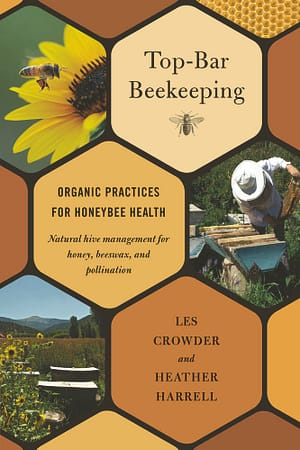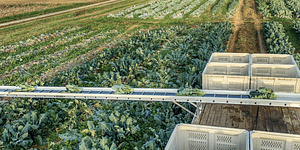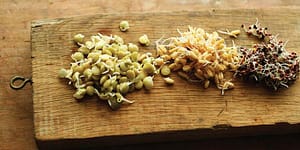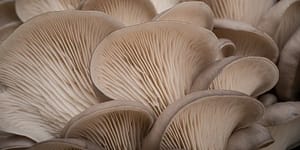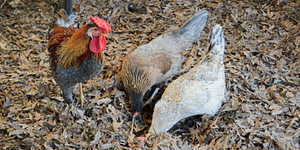Top-Bar Beekeeping: A List of Pros and Cons

Beekeepers are facing tremendous challenges, from pests such as varroa and tracheal mites and from the mysterious but even more devastating phenomenon known as Colony Collapse Disorder (CCD). Yet in backyards and on rooftops all over the world, bees are being raised successfully, even without antibiotics, miticides, or other chemicals. More and more organically minded beekeepers are now using top-bar hives, in which the shape of the interior resembles a hollow log.
The following is an excerpt from Top-Bar Beekeeping by Les Crowder and Heather Harrell. It has been adapted for the web.
Photo credit: John T. Denne.
Often I am asked why I made the transition away from Langstroth hives to top-bar hives. It is important to note that much of what we do as beekeepers will be the same no matter what kind of beehive we use, but there are significant differences in management, depending on hive design.

Pros of Top-Bar Beekeeping
One of my initial reasons for transitioning away from Langstroth hives was the need to store combs over winter. Langstroth hives have boxes called supers that are placed above the brood box for honey storage. Once the honey harvest is over for the season, supers are stored for the winter in the hope of preserving the combs for the following season. The storage of supers is a problem because wax moths and mice will eat and destroy the combs. In commercial operations, supers are fumigated with paradichlorobenzene to keep these pests away. Paradichlorobenzene, the chemical used in mothballs, is a known carcinogen that is absorbed by beeswax. The combs in the supers are treated with this chemical and then placed back into the beehives in the springtime to be refilled with honey. In a top-bar hive, however, there is no need to store combs through the winter, which eliminates both the problem and its chemical solution.
Langstroth hives are used in conjunction with sheets of wax or plastic called foundation. These sheets are imprinted with a designated cell size, one that’s designed to maximize honey production. Although foundation used to be made only from beeswax, industrial beekeepers are turning to the plastic foundation as a longer-lasting and therefore more economical choice for their businesses. Unfortunately, this plastic ends up as an industrial waste product when it is no longer useful. The predetermined cell size of foundation also presents a matter of debate within the organic beekeeping community.
In a natural environment, honeybees will draw out various sizes of cells depending on the needs of the hive, often using a variety of cell sizes on one comb. Bees commonly will build larger cells at the top of a comb and smaller cells at the bottom of the comb. The brood cell size also changes slightly over the course of a season, and the resulting physiology of the emerging bees shifts to correlate with this change. Bees born from larger cells are correspondingly larger and have more fat bodies. Studies have shown that substances in the fat bodies affect worker longevity and that these substances interact with brood pheromones.1 Bees born from smaller cells, in contrast, are smaller and show greater resistance to varroa mite.2 In top-bar hives, the bees are free to vary their cell sizes to meet the changing demands of the hive, and there is neither the expense nor the waste of plastic foundation. The management of hygiene and disease was also an integral part of my choice to use top-bar hives.
With the Langstroth system, honey is extracted from the comb by centrifugal force, which leaves the beeswax combs intact. This allows the beekeeper to put them back into the hive to be refilled by the bees. For maximum honey production, this extraction process makes a great deal of economic sense. The bees don’t have to rebuild the comb, which uses up a lot of the resources of the hive. The beekeeper thus profits from having more honey at a faster rate of harvest. However, the tendency in large commercial operations is to keep putting combs back into the hive after they’ve become a potential health risk for the bees in an effort to get as much use from them as possible before they are discarded.
Each time the queen bee lays an egg in a cell, the bee larva lines the cell with its cocoon during pupation. When the new adult bee emerges, the cocoon remains inside the cell, is cleaned out, and a new egg is laid. When the next adult bee develops, a second layer of cocoon is left behind, is also cleaned out, and the process continues. As time goes on, the cell size gets smaller and smaller, and the comb gets blacker and blacker due to a buildup of cocoons, propolis, and fecal matter inside the walls of the cells. The bees born inside these darker cells are smaller, and the hygiene of the hive eventually becomes compromised due to a greater level of pathogens. The temptation for commercial Langstroth operations to continue to use old black combs is great, as the cost of replacing combs means the cost of buying more foundation, as well as losing time and money on having the bees build fresh combs.
In top-bar hive management, a great deal of attention and care is given to cycling out old dark combs. They routinely are moved to the back of the brood nest so that they may be filled with honey and culled. The honey is harvested by taking the

Top-bar hives do not require an extractor. In the honey-bottling area, the combs are handcrushed over a tank with a strainer on top. The equipment can be as simple as a colander and a mixing bowl for small batches produced at home.
whole comb off the bar and crushing it, allowing the honey to drain out through a colander. The bees then have to draw out fresh comb to replace the comb that has been harvested. Although many Langstroth hive advocates believe that it is detrimental to require the bees to make more beeswax continually, the bees benefit from the regular conversion of honey to beeswax. It exercises their wax-making glands, which keeps their glandular systems active and healthy. Beeswax absorbs and holds oil- and fat-soluble toxins, which are unfortunately abundant in our current environment. As these toxins build up inside the hive, it becomes an increasingly toxic environment for the bees to live in. Continuously rotating and culling combs keeps the hive healthy because it removes wax-soluble toxins and cleanses the hive through regeneration.
Lastly, the Langstroth system requires some costly equipment. In order to produce honey in any volume, an extractor is a required expense. Extractors are stainless steel machines designed to pull the honey gently out of the combs through centrifugal force. Although extractors save time during honey harvest and preserve the combs, they have their drawbacks as well. Beekeepers who use an extractor tend to put off honey harvest until there is a large batch of honey to extract. The labor required to use and clean the machine simply isn’t justified with small batches of honey. In contrast, as a producer of varietal honeys, it’s in my best interest to harvest honey after each plant flow, no matter how large, so that I can bottle and sell unique flavors.
Cons of Top-Bar Beekeeping
The top-bar system certainly has some disadvantages, the main one being that top-bar hives require a high level of skill and confidence from the beginning beekeeper. The possibility for cross-combing is great, and once a top-bar hive has become cross-combed, it can be a very daunting task to clean up. Cross-combing happens when the bees draw their combs at odd angles to the top bars, sometimes spanning many bars at once, which causes the comb to drop and break when the hive is opened. The main skill of top-bar hive management involves spacing the combs so that the bees do not have a chance to cross-comb. On heavy honey flows in late summer, when there are a greater number of bees in the hive, it can be difficult to stay on top of management, especially if a beekeeper has a large number of hives. This makes top-bar hives a potentially discouraging choice for commercial beekeeping. It is also difficult to load and stack top-bar hives for large-scale pollination.
Another clear drawback to top-bar hives is that the bees have to build brand-new combs every time honey is harvested, which reduces honey production. The bees consume 9 to 11 pounds (4–5 kg) of honey to produce every 1 pound (0.45 kg) of beeswax, so the construction of new combs detracts from the amount of honey that gets stored in the hive. I experimented with five top-bar hives and five Langstroth hives one year and found that, on average, the top-bar hives produced 20 percent less honey and six times as much beeswax as the Langstroth hives. Many top-bar beekeepers utilize these higher wax yields by making candles, salves, and balms to diversify their businesses. The economic advantage of greater wax yields may well offset the disadvantage of lower honey production, depending on how beekeepers choose to market their wax products.
The natural top-bar movement has appealed mainly to home and hobby operators who have the time and interest in keeping bees intensively. Although there are some commercial top-bar operations across the United States, they are a small minority compared with the number of Langstroth operations. Most beekeeping publications are designed to serve the Langstroth community, and there is a great deal of support for beginners. Although there are support systems for top-bar hive enthusiasts, they tend to be small groups oriented toward lively discussions of hive design and home-built systems for harvest and wax utilization. Thankfully, this is slowly changing, aided by the Internet and a growing body of resources for top-bar hive beekeepers.
Recommended Reads
Recent Articles
Oxeye daisies are one of the most important plants for pollinators including beetles, ants, and moths that use oxeye daisies as a source of pollen and nectar. Instead of thinking about removing a plant like oxeye daisy, consider how you can improve the fertility and diversity of habitat resources in your home landscape, garden, or…
Read MoreSo you want to start reaping your harvest, but you’re not sure where to start? Learn how to break down the options of harvesting tools!
Read MoreWhat’s so great about oyster mushrooms? First, you can add them to the list of foods that can be grown indoors! They are tasty, easy to grow, multiply fast, and they love a variety of substrates, making oyster mushrooms the premium choice. The following is an excerpt from Fresh Food from Small Spaces by R. J.…
Read MoreEver heard the phrase, “always follow your nose?” As it turns out, this is a good rule of thumb when it comes to chicken manure. Composting chicken manure in deep litter helps build better chicken health, reduce labor, and retain most of the nutrients for your garden. The following is an excerpt from The Small-Scale Poultry…
Read More
